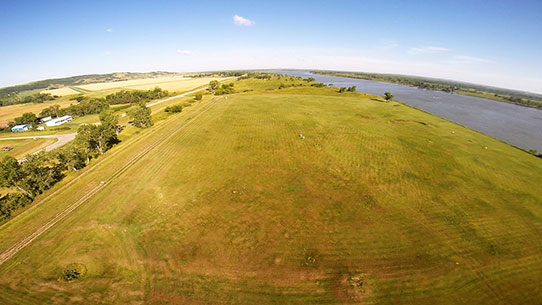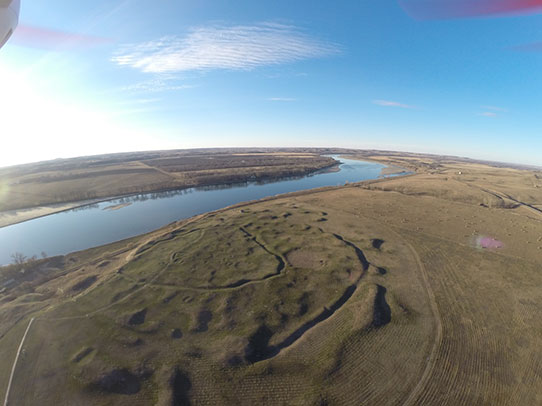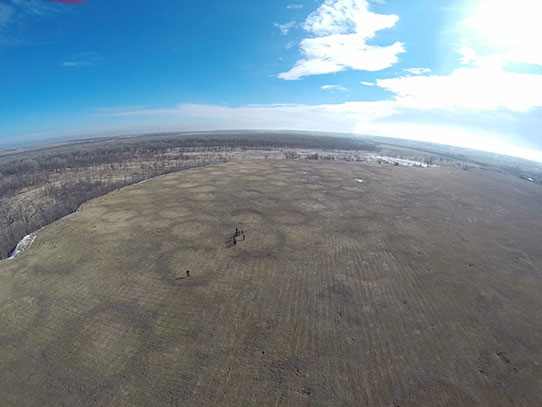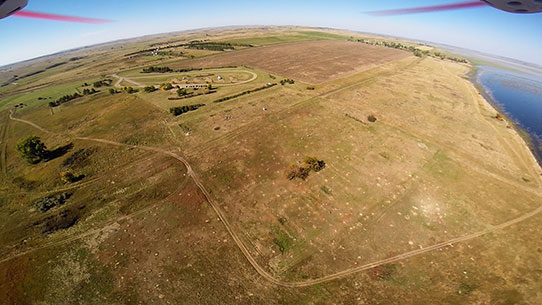A fellow blogger recently wrote that a visit to one of North Dakota’s state historic sites is “a bit like traveling in time” (see https://blog.statemuseum.nd.gov/blog/time-traveling-historic-sites). As my friend wrote, “A visit can give me a better perspective on what is happening in my own time.” This statement is spot on, and I couldn’t agree more!
One of my ongoing interests in recent years has been the emerging field of aerial photography via Unmanned Aerial Vehicles. A “U.A.V.” (or “drone”) elevates the concept of gaining “a different perspective in our own time” a step further to include the bird’s-eye view! I’ve talked about my interest in aerial photography before, most recently in a blog on the use of this technology to monitor ongoing erosion threatening Double Ditch Indian Village State Historic Site (see http://blog.statemuseum.nd.gov/blog/an-eye-in-the-sky-for-preservation.)
Thus far I’ve used a U.A.V. to capture aerial imagery at five of the 56 state historic sites managed by the State Historical Society of North Dakota. I should mention that all flights were over property managed by the SHSND and were flown in observance of guidelines established by the Federal Aviation Administration. I’d like to use this space to share some of my favorite aerial images of these sites with you!

Aerial view of Menoken Indian Village State Historic Site – April 2015
Menoken Indian Village State Historic Site marks the location of a village dating to AD 1200-1220. The village contains approximately 30 earthlodge depressions, and was home to about 200 people. The village is surrounded by a defensive ditch and palisade, and is an excellent example of the period of transition from a hunting-gathering subsistence to a hunting and gardening way of life. Menoken Indian Village is on the National Register of Historic Places and is located 11 miles east of Bismarck.
Visit http://history.nd.gov/historicsites/menoken/index.html for more information on Menoken Village State Historic Site.

Aerial view of Huff Indian Village State Historic Site – August 2014
Huff Indian Village State Historic Site is an ancestral Mandan earthlodge village dating to approximately AD 1450. This large community consisted of more than 100 rectangular earthlodges and was surrounded by a fortification ditch and bastion. Huff village was home to about a thousand people two hundred years before Europeans first entered what is known today as North Dakota. The lodge depressions visible at the site were laid out in an organized plan, evidence of a high degree of social and political structure within the village. We know this village was only briefly occupied, perhaps about 50 years. Huff Village is listed on the National Register of Historic Places and is located 22 miles south of Mandan, North Dakota.
Visit http://history.nd.gov/historicsites/huff/index.html for more information on Huff Indian Village State Historic Site.

Aerial view of Double Ditch Indian Village State Historic Site – November 2013
Double Ditch Indian Village State Historic Site is the location of a Mandan village occupied from AD 1490 to 1785. The state of preservation of the site is amazing, with more than 100 lodge depressions, many large refuse piles (called middens), and two fortification ditches visible on the surface. Recent geophysical and archaeological investigations at Double Ditch have demonstrated that there are two additional fortification ditches buried at the site. The population of the site was about 2,000 people at its height (larger than many small towns in North Dakota today!) The population declined to about 400 people by 1780. Double Ditch was decimated by a smallpox epidemic that swept through much of North America in 1781-1782. Survivors of this epidemic moved up the Missouri River to consolidate with the neighboring Hidatsa people in the Knife River region. Double Ditch village is located eight miles north of Bismarck and is listed on the National Register of Historic Places.
Visit http://history.nd.gov/historicsites/doubleditch/index.html for more information on Double Ditch Indian Village State Historic Site.

Aerial view of Fort Clark Trading Post State Historic Site – February 2016
Fort Clark Trading Post State Historic Site is the location of a large earthlodge village and two early fur trade posts on the Missouri River. The Mandan people built a village named Mih-tutta-hang-kusch” in this location in 1822. The American Fur Company established two trading posts in the area soon after to trade with the Mandan villagers and other neighboring groups. The village suffered heavily during the smallpox epidemic of 1837, and the Mandan again moved further up the Missouri River. The neighboring Arikara people moved into the abandoned village soon after in 1838 and continued to trade with the post until moving further upriver themselves in 1862. The site features at Fort Clark Trading Post are exceptionally well-preserved, with approximately 100 lodge depressions visible. Many features of the nearby Fort Clark trading post are also well preserved. Fort Clark Trading Post State Historic Site is located between Washburn and Stanton, North Dakota in Mercer County. The site is listed on the National Register of Historic Places.
Visit http://history.nd.gov/historicsites/clark/index.html for more information on Fort Clark Trading Post State Historic Site.

Aerial view of Fort Rice State Historic Site
Fort Rice State Historic Site is a great example of a military post established during a period of turbulent culture conflict on the Upper Missouri River. Built in 1864, the fort was established by General Alfred Sully to guard expanding northern plains trade routes rapidly expanding into lands claimed by groups of Dakota and Lakota peoples. The fort was eventually abandoned in 1878 with the establishment of Fort Yates on the nearby Standing Rock Agency. Many site features at Fort Rice are clearly visible today. Although no standing structures are present, the foundation outlines of the blockhouses, defensive palisade, and many other buildings are easily recognizable. Fort Rice is located 30 miles south of Mandan, North Dakota.
Visit http://history.nd.gov/historicsites/rice/index.html for more information on Fort Rice State Historic Site.
Finally, we want to hear from YOU ! The State Historical Society of North Dakota is seeking feedback from the public about visiting North Dakota State Historic Sites and Museums. Please visit http://history.nd.gov/survey.html to share your thoughts and experiences with us. All responses are confidential, and greatly appreciated. Your feedback will help us build a better experience for the site visitor. The survey period closes August 21, 2016.
Now that you’ve seen these sites from the air, I invite you to do a little “time traveling” of your own and visit these sites, and the other 51 State Historic Sites located in North Dakota. Enjoy summer and keep flying high!

